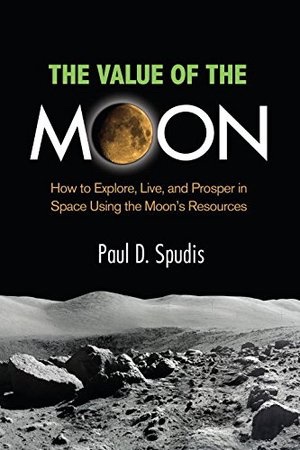Review: The Value of the Moonby Jeff Foust
|
| The VSE was a “conceptual breakthrough” in that in envisioned the use of lunar resources to support new spaceflight capabilities. Spudis claims, though, that NASA didn’t properly interpret it. |
Any US participation in Moon Village is unclear, and likely not to be significant, as NASA’s “Journey to Mars” program focuses on cislunar space versus the lunar surface as a proving ground in the 2020s for human missions to Mars in the 2030s. But some hope that, perhaps in the next administration, NASA will focus more on the Moon as a stepping-stone to Mars, abandoning efforts like the Asteroid Redirect Mission in the process.
If that happens, a good guide to what NASA could do on the Moon would be Paul Spudis’ new book, The Value of the Moon. Spudis, a lunar scientist and one of the strongest advocates for lunar exploration and utilization, makes the case for returning to the Moon, with robots and humans, to make use of resources there like water ice to create a cislunar infrastructure than can enable science, commerce, national security, and even missions to Mars.
The first part of the book examines the post-Apollo history of lunar exploration, and plans for such. Spudis offers an insider’s view of that effort, from both the point of view as a scientist involved with missions like Clementine and India’s Chandrayaan-1 as well as an advocate who served on committees, including the Aldridge Commission established after President George W. Bush announced the Vision for Space Exploration (VSE).
The VSE was, to Spudis, a “conceptual breakthrough” in that in envisioned the use of lunar resources to support new spaceflight capabilities. He claims, though, that NASA didn’t properly interpret it, seeking to minimize lunar plans in order to maintain a long-term focus on Mars. (If so, the Bush White House didn’t appear to make much of an effort to correct NASA’s misinterpretation.) Constellation was also poorly executed, leading to cost overruns and schedule delays that made it vulnerable to cancellation. What exists now, he argues, is a space program “without strategic direction and an uncertain future.” While NASA argues it’s on a journey to Mars, Spudis is skeptical that humans can go to Mars for the foreseeable future, or that any such efforts would be anything more than a temporary flags-and-footprints venture like Apollo.
Spudis then turns to what he thinks that strategic direction should be: a return to the Moon to use its resources. He describes his concept—which he has published previously—to establish a base at the lunar poles to access deposits of water ice believed to exist in permanently shadowed craters, while also making use of nearby regions of continuous sunlight. Such a base, he says, can eventually export water ice to depots in cislunar space, supporting activities ranging from satellite servicing to future human exploration, at lower costs than if propellant was brought up from Earth.
There is a certain logic to Spudis’ arguments: resources available from the Moon have the potential, at least, to improve the affordability of space operations. However, there are still many uncertainties, from the distribution and accessibility of water ice at the poles to the methods for accessing them. But those uncertainties should have the reader treat with some skepticism his $88 billion cost estimate (as of 2011) for establishing an initial lunar outpost capability; cost estimates for space programs rarely go down over time, after all.
| Why send humans to the Moon? There’s been no shortage of ideas, from science to commerce to national prestige, but by definition none so far have been sufficiently convincing: no one has been there since 1972. |
That initial outpost would make heavy use of teleoperated robots to create the infrastructure for the facility, including the initial production of water. The idea, Spudis argues, is to have a base ready to go for when the first astronauts arrive. But, if robots can handle all the excavation and production needs, what are the humans needed for? Spudis suggests that they will initially help repair and maintain the infrastructure, but one wonders whether it would cheaper to simply launch replacement robotic vehicles, or find some way to do robotic servicing, to continue production of lunar water.
This gets to the crux of not just the lunar development vision outlined by Spudis in his book, but also ESA’s Moon Village and other concepts for human lunar missions: why send humans to the Moon? There’s been no shortage of ideas, from science to commerce to national prestige, but by definition none so far have been sufficiently convincing: after all, no humans have been to the Moon since late 1972, and none are likely to return until at least some time in the 2020s.
There may yet be a compelling case for humans on the Moon; certainly most space advocates who envision a future of an expanding human presence into the solar system think so. If one does emerge, it’s likely that accessing lunar resources—of which water is just one—will play a key role in closing the case for a sustainable human presence there, as Spudis describes in The Value of the Moon. But while perhaps a necessary condition for a human return to the Moon, it alone may not be a sufficient condition, particularly if much, if not all, of work can be done robotically. More “jam sessions” may be needed to develop a stronger reason for humans to return to, and stay on, the Moon.
